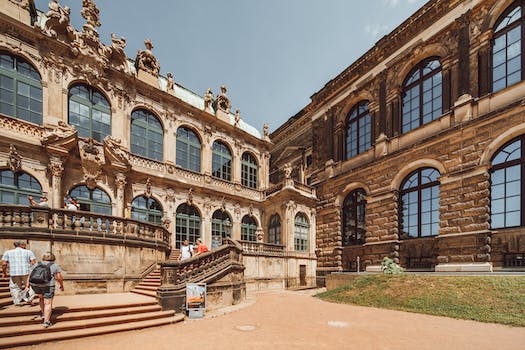

-
Table of Contents
"Embrace the past, embrace the future: Dresden's Resilience and Renaissance."
Introduction
Resilience and Renaissance in Dresden refers to the city's ability to recover and thrive after facing significant challenges throughout its history. Dresden, located in eastern Germany, has experienced periods of destruction and reconstruction, making it a symbol of resilience. Additionally, the city has undergone a renaissance in recent years, with a revitalized cultural scene and a focus on innovation and sustainability. This combination of resilience and renaissance has shaped Dresden into a vibrant and dynamic city.
The Historical Significance of Dresden's Resilience and Renaissance
Resilience and Renaissance in Dresden
Dresden, the capital city of the German state of Saxony, is a city that has witnessed both destruction and rebirth throughout its long history. The city's resilience and ability to rise from the ashes have made it a symbol of hope and renewal. From the devastating bombings of World War II to its remarkable reconstruction, Dresden's journey is a testament to the indomitable spirit of its people.
The historical significance of Dresden's resilience and renaissance cannot be overstated. The city's origins can be traced back to the early 13th century when it was founded as a small fishing village on the banks of the River Elbe. Over the centuries, Dresden grew in importance, becoming a cultural and economic hub in the region.
However, Dresden's fortunes took a turn for the worse during World War II. In February 1945, the city was subjected to a series of devastating bombings by the Allied forces. The bombings reduced much of Dresden to rubble, leaving behind a scene of utter destruction. The city's historic center, including its iconic Frauenkirche and Semperoper, was reduced to ruins.
In the aftermath of the war, Dresden faced a daunting task of rebuilding. The city's resilience was put to the test as its citizens rallied together to restore their beloved city to its former glory. The reconstruction efforts were not without challenges, but the determination and perseverance of the people of Dresden prevailed.
One of the most remarkable examples of Dresden's renaissance is the restoration of the Frauenkirche. This iconic church, which had stood as a symbol of Dresden's identity for centuries, was painstakingly rebuilt using the original plans and materials. The reconstruction of the Frauenkirche was not only a physical feat but also a symbol of hope and reconciliation. It served as a reminder that even in the face of destruction, beauty can be restored.
The restoration of other historic landmarks, such as the Semperoper and the Zwinger Palace, further exemplifies Dresden's resilience and commitment to preserving its cultural heritage. These buildings, which had been reduced to ruins during the war, were meticulously reconstructed, allowing future generations to appreciate their architectural splendor.
Dresden's renaissance was not limited to its physical reconstruction. The city also experienced a cultural revival, with a renewed focus on the arts and sciences. The Dresden State Art Collections, which house some of the world's most significant art treasures, were restored and expanded. The city's museums and galleries became vibrant cultural hubs, attracting visitors from around the world.
Today, Dresden stands as a shining example of resilience and rebirth. Its historic center, once reduced to rubble, now stands as a testament to the city's ability to overcome adversity. The city's rich cultural heritage, combined with its modern amenities, makes it a popular destination for tourists and a vibrant place to live.
In conclusion, the historical significance of Dresden's resilience and renaissance cannot be overstated. The city's ability to rise from the ashes and rebuild itself is a testament to the indomitable spirit of its people. From the destruction of World War II to its remarkable reconstruction, Dresden's journey is a symbol of hope and renewal. Today, the city stands as a testament to the power of resilience and the enduring human spirit.
Exploring Dresden's Cultural Renaissance: Art, Music, and Literature

Resilience and Renaissance in Dresden
Dresden, the capital city of the German state of Saxony, has a rich history that dates back centuries. From its origins as a small fishing village to its transformation into a cultural and artistic hub, Dresden has experienced both triumph and tragedy. Today, the city is experiencing a cultural renaissance, with a vibrant arts scene that encompasses art, music, and literature.
One of the most notable aspects of Dresden's cultural renaissance is its thriving art scene. The city is home to numerous art galleries and museums, showcasing a wide range of artistic styles and periods. The Gemäldegalerie Alte Meister, for example, houses an impressive collection of Old Masters, including works by Raphael, Rembrandt, and Vermeer. The Albertinum, on the other hand, focuses on modern and contemporary art, featuring pieces by artists such as Gerhard Richter and Neo Rauch.
In addition to its museums and galleries, Dresden also hosts a number of art festivals and events throughout the year. The Dresden Art Festival, for instance, brings together artists from around the world to showcase their work in various mediums, including painting, sculpture, and photography. The festival not only provides a platform for established artists but also serves as a launching pad for emerging talent.
Music is another integral part of Dresden's cultural renaissance. The city has a long-standing tradition of classical music, with a number of renowned orchestras and opera houses. The Semperoper, for example, is one of the most prestigious opera houses in the world, known for its exceptional performances and stunning architecture. The Dresden Philharmonic Orchestra, on the other hand, regularly performs at the Kulturpalast, delighting audiences with their renditions of classical masterpieces.
Dresden's music scene is not limited to classical music, however. The city also embraces a wide range of genres, including jazz, rock, and electronic music. The Jazzclub Tonne, for instance, is a popular venue for jazz enthusiasts, hosting regular performances by local and international artists. The city's vibrant music scene ensures that there is something for everyone, regardless of their musical preferences.
Literature also plays a significant role in Dresden's cultural renaissance. The city has a strong literary tradition, with a number of renowned authors and poets calling Dresden home. The Saxon State and University Library, for example, houses an extensive collection of books and manuscripts, including rare and valuable works. The library not only serves as a resource for scholars and researchers but also hosts literary events and readings, bringing literature to a wider audience.
Dresden's cultural renaissance is a testament to the resilience of its people. The city has faced numerous challenges throughout its history, including the devastating bombings during World War II that left much of the city in ruins. However, Dresden has managed to rebuild and reinvent itself, emerging as a vibrant cultural center that celebrates its past while embracing the future.
In conclusion, Dresden's cultural renaissance is a testament to the city's resilience and determination. Through its thriving art scene, vibrant music scene, and strong literary tradition, Dresden has established itself as a cultural and artistic hub. The city's rich history and commitment to the arts make it a must-visit destination for anyone interested in exploring the intersection of art, music, and literature.
Urban Development and Architectural Resilience in Dresden
Resilience and Renaissance in Dresden
Urban Development and Architectural Resilience in Dresden
Dresden, the capital city of the German state of Saxony, is a city that has experienced both devastation and rebirth throughout its history. From the destruction caused by World War II bombings to the subsequent efforts to rebuild and restore its architectural heritage, Dresden has emerged as a symbol of resilience and a testament to the power of urban development.
The city's architectural resilience can be seen in its historic center, known as the Altstadt, which was heavily damaged during the war. However, instead of simply rebuilding the city to its pre-war state, Dresden took a different approach. The city's leaders decided to embrace a philosophy of architectural renewal, blending the old with the new to create a unique and vibrant urban landscape.
One of the most notable examples of this approach is the Frauenkirche, a Baroque-style church that was destroyed during the bombings. Rather than reconstructing the church exactly as it was, architects and engineers decided to incorporate the original ruins into the new structure. The result is a stunning blend of old and new, a symbol of both the city's past and its future.
Another example of Dresden's architectural resilience is the Zwinger Palace, a magnificent Baroque complex that was also heavily damaged during the war. The palace has been meticulously restored, with great care taken to preserve its original features while also incorporating modern elements. Today, the Zwinger Palace stands as a testament to the city's commitment to preserving its cultural heritage while embracing progress.
In addition to its architectural resilience, Dresden has also demonstrated a remarkable ability to adapt and evolve in response to changing urban needs. The city's urban development initiatives have focused on creating sustainable and livable spaces that meet the needs of its residents while also preserving its historic character.
One such initiative is the revitalization of the Neustadt district, a formerly neglected area that has been transformed into a vibrant and diverse neighborhood. The district now boasts a thriving arts and culture scene, with galleries, theaters, and music venues attracting both locals and tourists alike. The revitalization of the Neustadt district is a prime example of how urban development can breathe new life into neglected areas, creating spaces that are both functional and aesthetically pleasing.
Dresden's commitment to urban development and architectural resilience has not gone unnoticed. In 2004, the city was awarded the European Union Prize for Cultural Heritage/Europa Nostra Award for its exemplary restoration and revitalization efforts. This recognition further solidified Dresden's reputation as a city that has successfully balanced preservation with progress.
In conclusion, Dresden's journey from devastation to rebirth is a testament to the power of resilience and the importance of urban development. Through its commitment to architectural renewal and adaptive urban planning, the city has transformed itself into a thriving cultural hub that embraces its past while looking towards the future. Dresden serves as an inspiration to cities around the world, showing that with determination and vision, even the most challenging circumstances can be overcome.
Q&A
1. What is resilience in Dresden?
Resilience in Dresden refers to the city's ability to recover and adapt in the face of challenges, such as the destruction caused by World War II and subsequent political changes.
2. What is renaissance in Dresden?
Renaissance in Dresden refers to the city's cultural and artistic revival, particularly during the 18th century when it became a center of European Baroque and Rococo architecture and art.
3. How has resilience and renaissance shaped Dresden?
The resilience of Dresden has allowed the city to rebuild and transform itself after periods of destruction, while the renaissance period contributed to its rich cultural heritage and architectural beauty that can still be seen today.
Conclusion
In conclusion, Dresden has demonstrated both resilience and a renaissance throughout its history. Despite the devastating bombings during World War II, the city has managed to rebuild and restore its architectural treasures, showcasing its resilience. Additionally, Dresden has experienced a cultural and artistic renaissance, with a thriving arts scene and a renewed focus on preserving its rich heritage. This combination of resilience and renaissance has made Dresden a vibrant and resilient city, attracting visitors from around the world.












